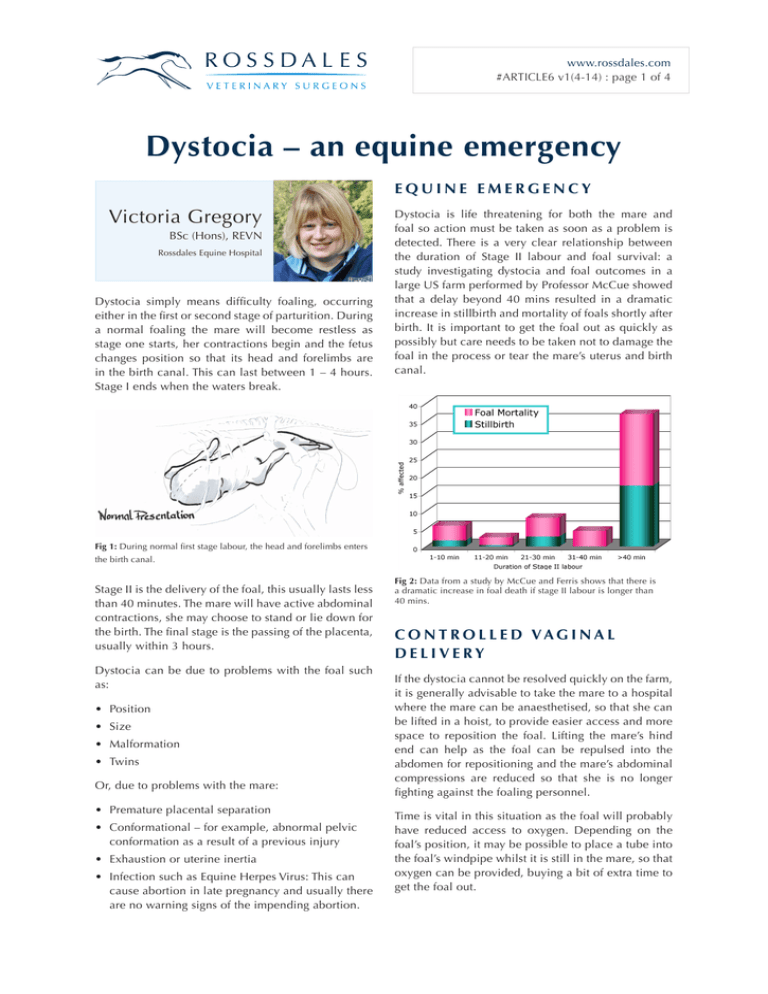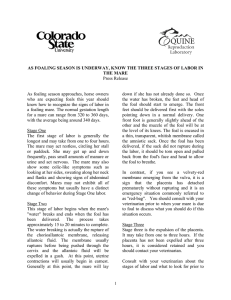
www.rossdales.com
#ARTICLE6 v1(4-14) : page 1 of 4
Dystocia – an equine emergency
EQUINE EMERGENCY
Victoria Gregory
BSc (Hons), REVN
Rossdales Equine Hospital
Dystocia simply means difficulty foaling, occurring
either in the first or second stage of parturition. During
a normal foaling the mare will become restless as
stage one starts, her contractions begin and the fetus
changes position so that its head and forelimbs are
in the birth canal. This can last between 1 – 4 hours.
Stage I ends when the waters break.
Dystocia is life threatening for both the mare and
foal so action must be taken as soon as a problem is
detected. There is a very clear relationship between
the duration of Stage II labour and foal survival: a
study investigating dystocia and foal outcomes in a
large US farm performed by Professor McCue showed
that a delay beyond 40 mins resulted in a dramatic
increase in stillbirth and mortality of foals shortly after
birth. It is important to get the foal out as quickly as
possibly but care needs to be taken not to damage the
foal in the process or tear the mare’s uterus and birth
canal.
Fig 1: During normal first stage labour, the head and forelimbs enters
the birth canal.
Stage II is the delivery of the foal, this usually lasts less
than 40 minutes. The mare will have active abdominal
contractions, she may choose to stand or lie down for
the birth. The final stage is the passing of the placenta,
usually within 3 hours.
Dystocia can be due to problems with the foal such
as:
• Position
• Size
• Malformation
• Twins
Or, due to problems with the mare:
• Premature placental separation
• Conformational – for example, abnormal pelvic
conformation as a result of a previous injury
• Exhaustion or uterine inertia
• Infection such as Equine Herpes Virus: This can
cause abortion in late pregnancy and usually there
are no warning signs of the impending abortion.
Fig 2: Data from a study by McCue and Ferris shows that there is
a dramatic increase in foal death if stage II labour is longer than
40 mins.
C O N T R O L L E D VAG I NA L
DELIVERY
If the dystocia cannot be resolved quickly on the farm,
it is generally advisable to take the mare to a hospital
where the mare can be anaesthetised, so that she can
be lifted in a hoist, to provide easier access and more
space to reposition the foal. Lifting the mare’s hind
end can help as the foal can be repulsed into the
abdomen for repositioning and the mare’s abdominal
compressions are reduced so that she is no longer
fighting against the foaling personnel.
Time is vital in this situation as the foal will probably
have reduced access to oxygen. Depending on the
foal’s position, it may be possible to place a tube into
the foal’s windpipe whilst it is still in the mare, so that
oxygen can be provided, buying a bit of extra time to
get the foal out.
www.rossdales.com
#ARTICLE6 v1(4-14) : page 2 of 4
S P E C I F I C CAU S E S O F DY S TO C I A
Analysis of the same group of cases has shown that
50% of severe dystocias in the hospital were due to
malpresentation of the foal, 17% were due to severe
contraction of the foals’ limbs, 8% were caused by
other severe conformational abnormalities, 6% due to
fetal oversize and 19% were due to abnormality or
disease affecting the mare.
Fig 3: A endotracheal tube has been placed in the foal’s windpipe to
allow delivery of an air using an Ambu bag, a compressible balloon
designed for this purpose. This provided oxygen for the foal during
delivery with the mare under general anaesthesia.
Once the mare is anaesthetised the position of
the foal is assessed again to see if it is possible to
do a controlled vaginal delivery. The team will start
this procedure but, progress is re-assessed at five
minute intervals and while attempts are being made
to deliver the foal, at the same time a nursing team
is simultaneously preparing the mare for abdominal
surgery. If after 10 minutes of repositioning and
pulling, the foal it is still not out, then a caesarean
section will considered.
CA E S A R E A N S E C T I O N
The main goal of Caesarean section is to save the
mare’s life. Having said that, where once there was
almost no expectation of achieving a live foal with
emergency caesarean section, in recent years, this
situation has improved. At Rossdales Equine Hospital,
analysis of 48 recent dystocia cases were admitted
to the hospital showed 46% had controlled vaginal
delivery under general anaesthesia and 54% had
caesarean section. The survival rate of mares was
similar with each procedure at just over 80%. Foal
survival was better with controlled vaginal delivery
with which 41% foals survived. Following caesarean
section, 19% of foals lived.
Fig 5: Causes of severe dystocia requiring hospital treatment in 48
mares at Rossdales Equine Hospital.
M A L P R E S E N TAT I O N
The most common reason for equine dystocia is
positional error and it is important to note that the
statistics above come from foalings in the hospital.
There are many less severe positional problems that
can be corrected on the farm. Carpal flex is the most
common followed by foot nape. These can be easily
corrected on the stud but care needs to be taken if
the foal is in the foot nape position, not to tear the
mare’s rectum. If it is a bilateral carpal flexure then a
controlled vaginal delivery will probably be needed
but you should consider the risk of the foal having
carpal contracture that may mean that a caesarean
section is required.
Fig 6: Carpal Flex, the most common form of malpositioning, can
often be resolved in the standing mare
Fig 4: Caesarean section is occasionally necessary; at this stage
the main goal is to save the mare. However, in 48 recent dystocia
cases, 19% of foals survived Caesarean section delivery at Rossdales
Equine Hospital
Fig 7: Foot Nape requires care as there is potential to damage the
mare’s rectum.
www.rossdales.com
#ARTICLE6 v1(4-14) : page 3 of 4
With posterior presentation, the foal can be delivered
at the stud but as the foal begins to move further out
the cord can get trapped, causing the foal to die if
delivery is not achieved very quickly.
Fig 8: During Posterior presentation there is a risk of compression
the umbilical cord the birth canal
Positions that are highly likely to require hospitalization
should ideally be identified promptly. Shoulder flex
is rare but can usually be resolved with a controlled
vaginal delivery.
Some foals that have their head in the wrong position
can be corrected on the stud but there is a risk that
when stimulating the foal’s head, it moves and makes
the deviation worse at which point, hospitalization is
required.
Dog sitting and ventral or dorsal transverse almost
invariably need caesarean section.
O T H E R C O M P L I CAT I O N S
A S S O C I AT E D W I T H T H E F O A L
If the foal is too large it may struggle to get its
shoulder through the birth canal and need to be
helped by pulling its forelegs and applying lots of
lubricant around the area. Malformation of the foal
may cause particular difficulty and is a common
reason for Caesarean. Hopefully twins will have been
detected early on in the pregnancy but if not then this
can cause problems if they are both in the birth canal
together.
C O M P L I CAT I O N S
A S S O C I AT E D W I T H T H E
M A R E A N D H E R P L A C E N TA
During an uncomplicated foaling, the foal will be
delivered with the amniotic sac, this breaks as the
foal’s nose and feet push through the sac, allowing the
foal to breathe. The placenta is then delivered after
the birth. Premature placental separation results in the
foal being born still inside the placenta, commonly
referred to as a ‘red bag delivery’. When the placenta
separates prematurely the foal is not strong enough to
break the placenta. As the foal is born, the first thing
to be seen is the placenta – a ‘red bag’. This must be
broken immediately as it is preventing the foal from
breathing. A ‘red bag’ foal should be monitored closely
after birth for normal behavior as it may have been
starved of oxygen during birth and need veterinary
attention to decrease the risk of further deterioration.
Fig 9: Shoulder flex typically can be resolved during controlled
vaginal delivery
Fig 11: Dog sitting usually requires Caesarean.
Fig 10: Ventral retroflexion is an example of a condition in which
the foal’s head is in an abnormal position. The head can also
retroflex dorally so that it is looking along its back towards its
hindquarters.
Fig 12: With ventral transverse, all four limbs are in the birth canal.
With dorsal transverse, all four limbs and the foal’s head are towards
the mare’s thorax, with the foal’s hind end upwards. These positions
usually require Caesarean section.
www.rossdales.com
#ARTICLE6 v1(4-14) : page 4 of 4
If the mare has conformation problems, such as an
old injury to her pelvis or previous foaling injuries,
which mean that the mare cannot foal naturally, it is
sometimes decided that the mare will have elective
(i.e pre-planned) caesarean section.
POTENTIAL FOR
C O N TAG I O U S D I S E A S E
If the mare is having a difficult foaling but there is
no apparent reason for the difficulties, Equine Herpes
Virus (EHV) should be considered as a possibility,
particularly if the mare is foaling early. EHV foals are
often still born but occasionally, there is a live foal
with EHV although usually the foal will show signs
of severe illness soon after birth, typically respiratory
signs and jaundice with very low white blood cell
counts. With unexplained stillbirths, the mare
should be isolated until the possibility of infection
is investigated and you must make sure that you
wear overalls, foot covers and gloves. The fetus and
placenta can be tested for EHV using PCR techniques
that provide a very quick result. Ideally, a separate
team should look after the mare and all areas that the
mare has been in should be disinfected appropriately
to help prevent viral spread.
SUMMARY
With the high number of foalings seen each year there
are bound to be some problems. The key is to know
what to look out for and to call someone experienced
in foaling as soon as a problem is detected. Red bag
foalings are common and disaster can be averted if
the placenta is broken to allow the foal to escape.
A speedy delivery is vital for the foal but, pulling a
poorly positioned foal can be fatal for the mare and
foal so it is important to make a prompt assessment of
the foal’s position and realistic assessment of whether
hospitalisation is necessary. Controlled vaginal
deliveries under general anaesthesia will often result
in a live foal. Caesareans are important to save the
mare’s life, but outcomes for Caesarean foals are more
guarded.
All illustrations by Jim Power
© Copyright 2014 Rossdales. All rights reserved.
All information is copyright of Rossdales and may be amended/updated at any time.
Please refer to our website for the latest information. www.rossdales.com







